Exhibition: A Pictorial Review, Greater New York's Silver Jubilee, May 26-June 23, 1923
A Digital Initiatives Department Exhibit, B. Davis Schwartz Memorial Library, February 14-March 20, 2011.
- Documentation of the Exhibit
- Jubilee
- Education
- NYC Fire Department
- NYC Police Department
- NYC Street Cleaning
The City of New York's Silver Jubilee
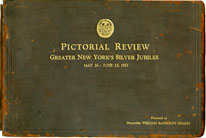
Pictorial Review-Greater New York's Silver Jubilee, May 26 - June 23, 1923 (wrh_pr1_001.tif)
In 1976, Long Island University received the William Randolph Hearst Collection as a gift from the Hearst Corporation. The collection consisted of photographs, record books, art auction catalogues, aperture cards and some miscellaneous books. Two of these books, Pictorial Review, Greater New York's Silver Jubilee; Volumes I and II, are the basis for this exhibit. William Randolph Hearst was presented this scrapbook collection of archival photographs from the Mayor's Committee on Celebration of the Twenty-Fifth Anniversary of the Greater City of New York. The Silver Jubilee celebration consisted of the Municipal Educational Exposition held at Grand Central Palace from May 28, 1923 to June 23, 1923, and the civic, industrial and fraternal parades held on May 26, June 16, and June 23, 1923, respectively. Hearst served as Vice Chairman of the General Committee for the Silver Jubilee.
The 1923 Jubilee was the silver anniversary of the consolidation of the City of Greater New York. The 1898 consolidation combined the counties of the Bronx, Kings, New York, Queens and Richmond which contained the three cities of Brooklyn, Long Island City and New York. The Municipal Educational Exposition was intended to educate and entertain by showing exhibits that emphasized the growth in the City of Greater New York. One of the displays at the Exposition's entry was Father Knickerbocker, designed to symbolize the rich Dutch heritage of the City of New York. Harmen Jansen Knickerbocker was one of the earliest settlers of New Amsterdam who later moved to Albany. Another display at the Exposition was a gigantic map of the city over 30 feet tall and wide with 2,600 lights, showing every piece of property and building owned by each municipality. The Police Department was lit green, the Fire Department in red, etc.
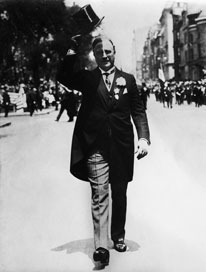
Silver Jubilee Grand Marshal Mayor John F. Hylan (wrh_pr2_142.tif)
The Silver Jubilee was heavily supported by the Mayor and was organized by the Mayor's Committee. Mayor John F. Hylan served from 1918 to 1925. His nomination as the Democratic candidate in the 1917 election was largely a result of his political association with Hearst, who was influential in Tammany Hall, New York's Democratic machine. Two other men were also instrumental in the Jubilee, Rodman Wanamaker and Grover A. Whalen. Wanamaker, a merchant educated at Princeton, was a Chairman for the General Committee, and was also a Vice Chairman for the Advisory and Finance Committee. Whalen was the Presiding Vice Chairman of the General Committee and the Vice Chairman of the Advisory and Finance Committee.
City of New York Anniversary Celebrations Since 1923
Since 1923, City of New York consolidation anniversaries were held with less grandeur to them and more of an emphasis on history and celebration. In 1948, a Golden Jubilee was planned to celebrate the Fiftieth Anniversary of the City of Greater New York. Like its predecessor, the Golden Jubilee was an attempt to show the years of progress since the city was consolidated and included an educational exposition at Grand Central Palace as well as an air show by the Port of New York Authority. In 1973, the Diamond Jubilee was planned as more of a year-long celebration across the city, with a Fourth of July fireworks show on Governor's Island. Particular attention was placed on the Brooklyn Bridge in 1973, which was celebrating its ninetieth birthday, because of its importance to the growth of the city. In 1998, to celebrate the city's one hundredth birthday, the Museum of the City of New York opened a year-long exhibition titled, The New Metropolis: A Century of Greater New York, 1898-1998. Other celebrations included a Centennial Weekend with fireworks over the boroughs, a swimming race at the Little Red Lighthouse, neighborhood parades and a concert in Central Park.
Hearst and the Silver Jubilee
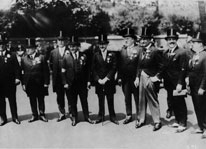
Group picture showing local officials (wrh_pr2_141.tif)
Mayor Hylan's opponents often criticized the Mayor's ties to William Randolph Hearst. In a statement contained in the minutes of an April 6th, 1923 Silver Jubilee Advisory Committee meeting, Hylan was quoted as saying that Hearst would spend as he felt necessary in order to back the celebration.
Angela M. Blake, the author of the book How New York Became American: Business, Tourism, and the Urban Landscape, 1890-1924, cited Mayor Hylan's papers kept at the New York Municipal Archives as her source for a number unidentified press clippings regarding the Jubilee. Blake found a news report that suggested that since 1923 marked the fifty-ninth and sixtieth birthdays of the Mayor and Hearst, respectively, the Jubilee was could be a guise for a huge municipal birthday party at the city's expense. Blake extracted the following quote from a press report in the Mayor's Archive, 'Why not a huge municipal birthday party at the City's expense, naturally-to express the upwelling gratitude of the people of New York to those their great benefactors?' Blake also reported on conflicting press reports for and against the Jubilee. For example, the Jubilee was touted as a waste of money for the city because there was 'No public demand for it.' Still other accounts claimed that celebration promoted New York and was 'a wise expenditure of the taxpayer's money for the good of the people.'
A Celebration of the 25th Anniversary of Consolidation
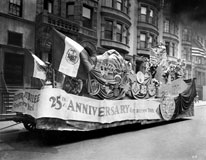
New York City's official float 'Civic Fame Welcomes Fraternity' (wrh_pr2_226.tif)
At pace with most public events of the City of New York, the Silver Jubilee had its fair share of political drama because of its expense and because it was seen as a way to achieve political promotion. Comptroller Charles Craig of the Board of Estimate refused to release city funds required to finance the celebration. Craig warned that the use of city employees for the preparation of the Jubilee was illegal and that he would refuse to certify pay checks. William J. Schieffelin, the Chairman of the Citizen's Union, prevented the issue of $400,000 in special revenue bonds required for the Jubilee. On April 12, 1923, the Finance Committee of the Jubilee sent an appeal to the merchants and business men of New York City to aid in the $500,000 fund to pay for the Jubilee. At the closing ceremony, Whalen stated the exposition had cost $500,000 which was raised by the combined effort of the businessmen that obtained subscriptions, and by the sale of tickets and the proceeds from the concessions. Mayor Hylan called those who had attempted to halt it 'trouble makers.' Mayor Hylan reiterated that 'this administration works for the people and serves the people' and that 'the greatest menace we have today is the misleading, false and lying statements printed every day in the newspapers about public officials who are faithfully trying to do their duty.'
The Parades to Celebrate the 25th Anniversary of Consolidation
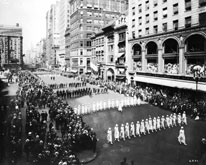
Staff of the Board of Education (wrh_pr2_174.tif)
The civic parade opened the Jubilee on May 26 with 40,000 city employees marching down Fifth Avenue for almost five hours. The Governor of New York at this time was Alfred E. Smith, 'the Happy Warrior,' who was also involved in Tammany politics. One interesting note, the band following the Dock Department halted and began to play 'How Dry I Am' in front of Governor Smith and Mayor Hylan. During the Prohibition Era, Governor Smith was a known denouncer of the Eighteenth Amendment and a particular legislative act regarding Prohibition, named the Mullan-Gage Act, was in public awareness. The crowd and Governor Smith were amused by the music however Mayor Hylan was not and attempted to get a police officer to have the band move on. By the time the officer arrived, the band had already moved.
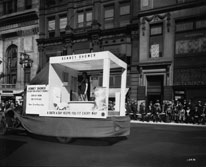
Float of the Kenney Cutting Products Corp. (wrh_pr2_215.tif)
The industrial parade on June 16 highlighted the industrial progress since consolidation with many decorative floats. The food products industry dominated about one-third of the parade. Many of the 50 bands played the song 'Yes, We Have No Bananas.' The Kenney Cutting Products Corp. had a float displaying the Kenney Shower, complete with a girl in a bathing suit in a mock shower. The Life Savers exhibit had six girls in bathing suits riding trucks designed to look similar to the traditional candy made by the company. Hearst's own Pictorial Review, one of his many publications, had a large delegation of employees as well vehicles depicting its growth.
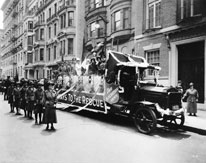
Salvation Army float escorted by Salvation Army Cadets (wrh_pr2_232.tif)
The fraternal parade on June 23, the largest of the three parades, marked the closing of the Jubilee with the marching of nearly 50,000 fraternal organizations. The Salvation Army led the groups of those who participated, which included the Masonic and Knights of Columbus as well as a group of Black American Elks with a jazz band and the Catholic Daughters of America.
Grand Central Palace
Dynamic and iconic, New York City is one of the most recognizable landscapes of the modern world, as John Lennon put it, parallel to the grandeur and status of Rome for the Roman Empire. Like Rome, the vigor of the city resides not only in the will and character of the Vox Populi, but also in the edifices that house, hone, and shape that city. If we can accept that, we can see that the structures surrounding us can be the watermark or the bell that links us to the sound of our past. But what of the landmarks that have vanished? The Grand Central Palace was one case of sacrifice and exorcised spirit of the New York City cityscape.
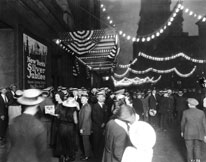
Crowds at main entrance to Municipal Educational Exposition at Grand Central Palace awaiting the arrival of His Honor, the Mayor (wrh_pr1_030.tif)
The Grand Central Palace was regarded as being the successor to the Old Madison Square Garden, the epicenter of New York. Located on Lexington Avenue between Forty-sixth and Forty-seventh Streets in midtown Manhattan and completed in the May of 1911, it replaced the former Grand Central Palace located four blocks south, which was to be demolished to make way for the city's New Grand Central Terminal. Thirteen stores tall, the Grand Central Palace devoted three of its floors to be expressly used for exhibitions. The floors' area combined to create a space of 126,000 square feet or 27 acres, an exhibition space four times greater than the then main hall of Madison Square Garden. The size was a major factor in the preference of the new Palace to the Garden, since the new Palace wasn't constricted by the same architectural space as the Garden it could offer a permanent housing for touring auto shows, where the Garden would have to erect temporary housing to accommodate the size. In addition to not needing temporary structures, the space of the Grand Central Palace being divided into three floors also meant the new Palace could also host several exhibitions simultaneously.
'April 1917 the First Annual Exhibition of the Society of Independent Artists. Dadaist art critic Arthur Cravan was arrested there for shouting obscenities and undressing during a lecture'.
Grand Central Palace by Dru Parrish, Palmer School intern. Fall 2010.
Municipal Educational Exposition at Grand Central Palace
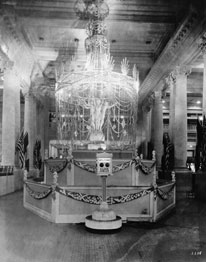
Fountain of Jewels-Special feature at the Silver Jubilee Exposition (wrh_pr1_019.tif)
The Municipal Educational Exposition was contained within four floors of Grand Central Palace and in a four block arcade adjacent to the Palace on Park Avenue. The display on the main floor was a large bell, the 'fountain of jewels,' which was 40 feet in height containing 30,000 pieces of Austrian cut glass in half a dozen colors. Also on the main floor were exhibits of the Mayor's office which contained the city's original charter guarded by a special policeman, the Board of Estimate and the five Borough Presidents. The remaining floors contained exhibits from various hospitals and other municipal departments as well as displays from the Department of Corrections and Police Department. The various exhibits at the Exposition showcased the changes in each department, from everything from the police to street cleaning. Where there was one bridge spanning the East River at the time of consolidation, in 1923 there were three. Where there was close to six million people in the city in 1923, the population was under four million in 1898. Prior to consolidation, assessed value of real estate was $2,464,763,192 with the 1923 amount at $10,596,065,573.
